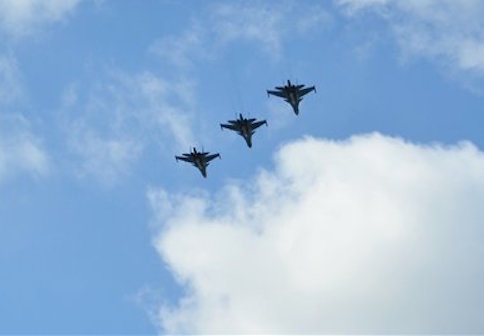The U.S. Navy scrambled fighter jets last Thursday in an unsuccessful attempt to stop Russian jets from bombing American-backed rebels in Syria, a development that will likely contribute to increasingly frosty relations between Washington and Moscow.
The close encounter occurred on June 16 near Syria’s southern border with Jordan when multiple Russian Su-34 aircraft struck the At Tanf garrison, which housed roughly 200 U.S.-backed rebels fighting ISIS, the Daily Beast reported. The strike, which occurred in an area where Russian jets had not previously been active, led the Navy to scramble F/A-18 fighter jets from one of the two U.S. aircraft carriers currently stationed in the Mediterranean Sea to support operations against ISIS.
Russia, an ally to Syrian President Bashar al-Assad, began its air campaign in Syria last September with the goal of fighting ISIS. However, Russian air strikes have appeared to target rebels fighting the Assad regime.
The Daily Beast reported:
As the F/A-18s approached the Su-34s, officials with U.S. Central Command--which oversees America’s wars in the Middle East and Afghanistan--used a special hotline to contact their Russian counterparts directing Russia’s own intervention in Syria. Arriving over At Tanf, the American pilots apparently spoke directly to the Russian aviators. "Pilots CAN communicate with one another on a communications channel set up to avoid air accidents," Central Command confirmed in a statement to The Daily Beast. ... With the American jets flying close enough to visually identify the Su-34s, the Russians departed the air space over At Tanf. Some time shortly thereafter, the F/A-18s ran low on fuel and left the area in order to link up with an aerial tanker. That’s when the Su-34s reportedly returned to At Tanf —and bombed the rebels again.
The second bombing killed several Syrian rebels trying to deliver medical aid to individuals wounded in the initial strike, the Los Angeles Times reported Friday.
Pentagon officials expressed strong concerns over the Russian airstrikes during a video conference with their Russian Defense Ministry counterparts on Saturday, the Defense Department said in a release over the weekend.
"Department officials expressed strong concerns about the attack on the coalition-supported counter-ISIL forces at the At-Tanf garrison, which included forces that are participants in the cessation of hostilities in Syria, and emphasized that those concerns would be addressed through ongoing diplomatic discussions on the cessation of hostilities," Pentagon press secretary Peter Cook said in a statement.
"Regarding safety, department officials conveyed that Russia’s continued strikes at At-Tanf, even after U.S. attempts to inform Russian forces through proper channels of on-going coalition air support to the counter-ISIL forces, created safety concerns for U.S. and coalition forces."
"The two sides reiterated the need to adhere to measures to enhance operational safety and avoid accidents and misunderstandings in the air space over Syria," Cook added.
The hotline used by American pilots to communicate with the Russians was established under the "Safety of Flight Memorandum of Understanding," an air safety pact agreed upon by Russia and the United States in October in order to avoid confrontations in the airspace over Syria.
Meanwhile, Russia’s defense ministry claimed in a statement over the weekend that Russian jets did not bomb U.S.-backed rebels near the border with Jordan.
"The object which had suffered bombardment was located more than 300 km far from borders of territories claimed by the American party as ones controlled by the opposition joined the ceasefire regime," the ministry said in a statement Sunday, according to CNN.
The Kremlin also said that Russian forces "forewarned member states of the U.S.-led coalition about the ground targets to strike on."
